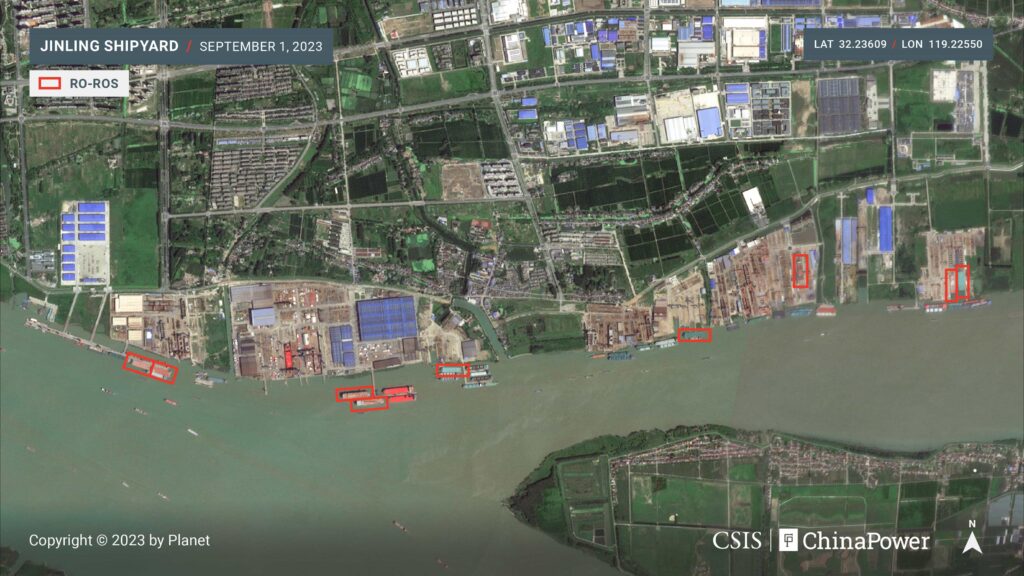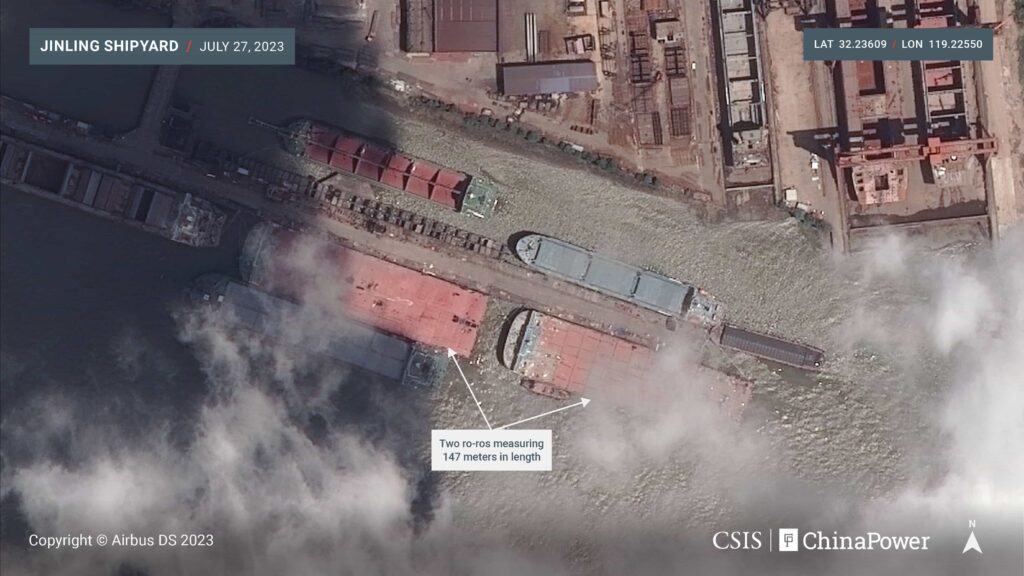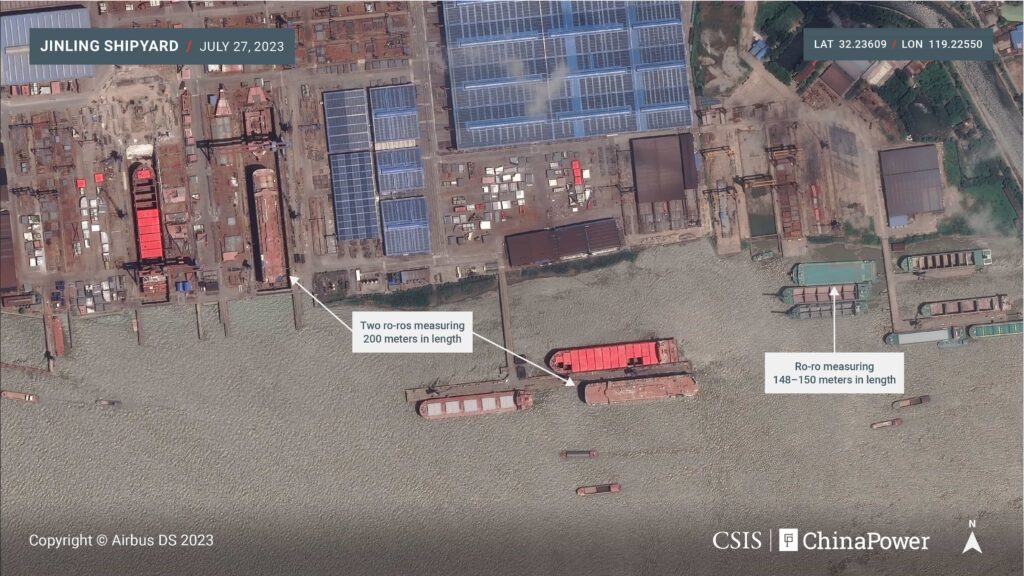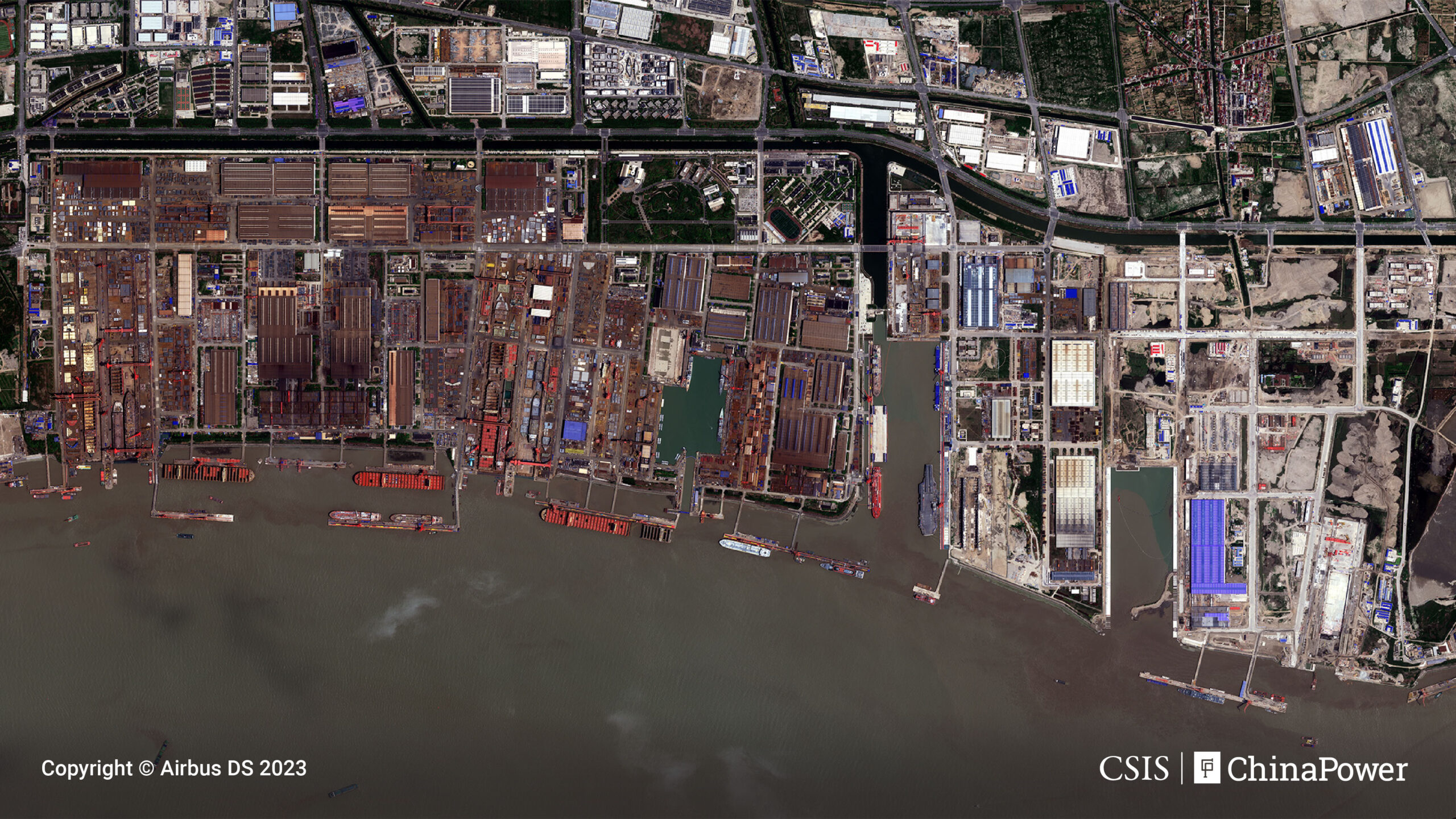By: Matthew P. Funaiole, Brian Hart, Jaehyun Han, and Jennifer Jun
October 11, 2023
Driven by surging electric vehicle sales, China has quickly established itself as a global powerhouse in the automotive industry. Meeting demand has pushed Chinese automakers to order record numbers of “roll-on/roll-off” (ro-ro) ships—which are specifically designed to ferry vehicles to distant markets.
While ro-ros are generally innocuous, Chinese military planners have taken note of their dual-use capabilities and are making use of the ships to enhance the capabilities of the People’s Liberation Army (PLA).
Demand for Chinese Ro-Ros Ramps Up
Global demand for affordable cars, especially Chinese-made electric vehicles, has exploded. In the first eight months of 2023, Chinese exports of passenger vehicles reached RMB 321.5 billion ($45.7 billion), nearly six times the total of all of 2019.
As demand accelerates, Chinese automakers are increasingly in need of additional ro-ros to transport their vehicles. Whereas containerized freight is typically loaded and unloaded onto ships by massive cranes, ro-ros allow for wheeling cars directly on board via a ramp. The interior of these ships is designed similarly to a multi-level parking garage, with ramps connecting different levels, enabling vehicles to move between floors. Today’s largest ro-ros are gargantuan in size, with carrying capacities of some 9,000 car equivalent units (CEU).1
China’s current dearth of ro-ros has become painfully evident in recent years. In a July 2023 report in the Party-run news outlet People’s Daily, a Chinese industry expert notes, “There are more than 700 ro-ro ships worldwide, with less than 100 being operated by major sea transportation service providers in China.” Compounding the issue, the vast majority of these are not designed for ferrying vessels across far seas and are instead limited to regional transportation.
Chinese companies need to rapidly grow their fleets of ro-ros to continue expanding into overseas markets. Fortunately, China is well-placed to build them.
In 2022, Chinese shipyards produced 47 percent of the world’s commercial vessels (by gross tonnage). South Korea and Japan were the only other countries to produce a sizable share of global fleets, respectively building 29 percent and 17 percent of the total.
Ship order books indicate that China is poised to see a dramatic uptick in the construction of ro-ros in the coming years. Data compiled by the authors shows that Chinese shipyards may deliver upwards of 200 ro-ros between 2023 and 2026 (including options).2 That amounts to twice the number of ro-ros delivered from 2015 to 2022. Chinese shipyards could see their order books swell even further as additional orders for ro-ros are added.
One shipyard in particular, CSC Jinling Shipyard (招商局金陵船舶(南京)有限公司) far outpaces other ro-ro builders. Nestled along the Yangtze River near Nanjing, Jinling Shipyard specializes in producing ro-ros. It built at least 27 of them between 2015 and 2022, and it is currently poised to deliver as many as 56 from 2023 to 2026.
Commercial satellite imagery reveals the scope of ro-ro construction activity at Jinling Shipyard. In imagery captured on September 1, 2023, nine ro-ros are visible: six moored at piers jutting out into the river and three resting in construction ways on the shore.

Click to enlarge
Higher resolution satellite imagery from July 27, 2023, offers a closer look. Seven of the ro-ros measure approximately 147–150 meters in length while the other two are 200 meters long (or more than two football fields).
Based on the size of these vessels and details of recent orders, the two larger ro-ros are likely part of a batch of six liquid natural gas-powered car carriers ordered by Singapore-based company Eastern Pacific Shipping (EPS) in 2021. The massive vessels are sized at 7,000 CEUs each, and the original four vessels in the order each came with a price tag of $87 million.3


These vessels are being rapidly built. Analysis of commercially available imagery over the past four years indicates that once pre-fabricated hull blocks are constructed, workers can weld the hull together and have it ready for fitting out in a matter of weeks. The hull blocks of the large EPS vessels were pieced together in just six weeks before entering the water for fitting out.
Jinling is not China’s only major producer of ro-ros. Other shipyards are poised to see dramatic growth in their output. CSSC Guangzhou Shipyard has built only four ro-ros in recent decades, but new orders could see the shipyard produce 42 more ro-ros through 2026. Similarly, CSSC Waigaoqiao Shipyard in Shanghai has not produced any ro-ros in recent years, but it could produce as many as 13 between 2025 and 2026.
While many of these ships are being delivered to foreign buyers, a large portion of them will remain in China. Of the nearly 198 ro-ros ordered from Chinese shipyards through 2026, about 39 percent (76 ships) were ordered by Chinese companies.
In a bold bet on continued high demand, some Chinese car companies are ordering their own carriers. In 2022, China’s top electric vehicle manufacturer BYD reportedly ordered six ro-ros (with options for two more) at a cost of approximately $689 million. The vessels are expected to feature a capacity of some 7,700 CEUs each. Other Chinese automakers, like SAIC, have ordered several of their own ships as well.
Key companies are even setting up their own shipyards. The state-owned automaker Chery is partnering with Wuhu Shipyard to re-develop an old shipyard into a car carrier construction base on the coast of Shandong Province.
The Dual-Use Applications of Ro-Ros
At face value, China’s push to rev up production of ro-ros should not raise eyebrows. Yet there is clear evidence that the Chinese military intends to utilize ro-ros to support military operations.
While China has made significant strides in modernizing its military, it still faces limitations. The U.S. Department of Defense assessed in 2020 that the PLA has demonstrated “a near term focus on regional and eventually global expeditionary missions rather than the large number of landing ship transports and medium landing craft that would be necessary for a large-scale direct beach assault.”
In other words, the PLA lacks sufficient military hardware to transport large numbers of troops and equipment to key theaters. Most notably, the PLA would need to mobilize additional equipment to conduct a large-scale joint island landing campaign against Taiwan.
Civilian ro-ros can help to fill that gap. In May 2018, Chinese official media reported that a 10,000-metric ton ro-ro was used by the PLA Air Force to transport officers, troops, and equipment more than one-thousand nautical miles along the Chinese coast. The report notes that the company that owns the vessel worked with the PLA and “carefully selected a vessel that met national defense requirements.”
As part of ongoing efforts to modernize the Chinese navy, work is underway to transform Shanghai’s Changxing Island into a colossal “shipbuilding base.” Explore ChinaPower analysis and satellite imagery of Changxing Island.
The PLA has more recently begun to incorporate ro-ros directly into amphibious assault exercises. The first publicly known instance of this came in 2019 when the 15,000-ton ro-ro Bang Chui Dao participated in an amphibious assault exercise. It has since become commonplace. Open-source analysis indicates that, in 2022, 30 separate commercial ro-ros were observed supporting large-scale PLA lift exercises.
However, civilian ro-ros do come with drawbacks. In a wartime environment, the vessels would be slow-moving, easy targets and require heavy defenses from attacking aircraft and warships armed with anti-ship missiles. There are also technical hurdles to overcome. The vehicle lanes on civilian ro-ros may be too narrow to accommodate many tracked armored vehicles. Internal clearance constraints, such as on elevators, could further limit the types of vehicles that can be stowed on each deck.
One of the more significant challenges lies in the design of the ramps. Ro-ros typically feature freight decks situated much higher above the waterline, which are designed to align with the height of ports’ quay walls. To launch and recover equipment like the Type 05 amphibious armored vehicle, ro-ros need to be outfitted with reinforced ramps capable of spanning varying distances, especially in different environments like beach landings.
To address this, the PLA has retrofitted some ro-ros with new ramps that enable in-water operations for the launch and recovery of amphibious combat vehicles. The PLA has even worked directly with shipbuilders to incorporate features into ro-ros that meet military requirements, including helipads, medical equipment, improved command and communications equipment, greater freight deck ventilation, and more.
Official reports frequently highlight ro-ros as a key example of military-civil fusion (MCF), China’s national strategy for fusing together the country’s economic and military development to support national security objectives.
China has also strengthened the legal framework to use them and other civilian vessels to support military and national security needs. In 2016, the Chinese government passed the National Defense Transportation Law, which requires Chinese companies engaged in international shipping to “provide assistance in personnel rest and resupply for ships, aircraft, and automobiles participating in international rescues, maritime escorts, and military operations in defending national interests.”
It is worth noting that the use of commercial ro-ros for military ends is not the norm for other countries. A 2023 unclassified document by U.S. Indo-Pacific Command states that “U.S. policy does not allow the use of non-warships for belligerent acts.” The document further asserts that “by demonstrating intent to use commercial [ro-ros] during an amphibious invasion, the PLA is eroding the principle of distinction under the law of armed conflict (LOAC) and obscuring crucial lines between warships and non-warships[.]”
Not all Chinese ro-ros should be suspect. Many of them may never be called on to support the PLA. Nevertheless, China has made clear that these vessels are important assets that can fill gaps in the PLA’s capabilities. As Chinese shipyards produce more and more ro-ros to meet growing commercial demand, analysts should pay close attention to how the PLA may incorporate them into its planning and capabilities.


